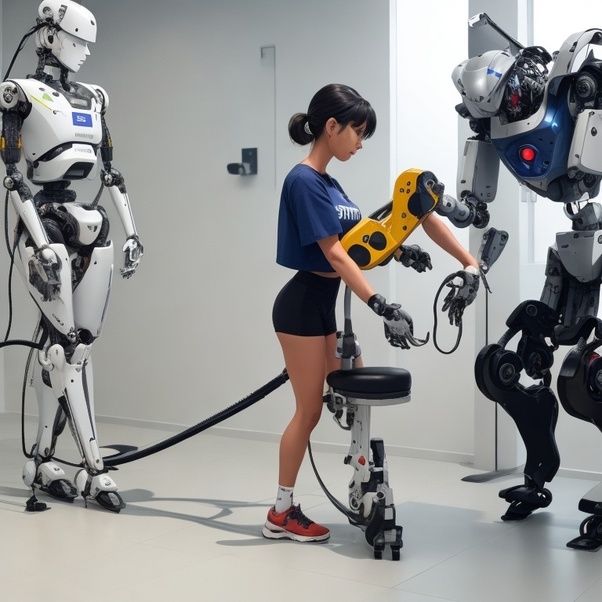Introduction
Robot-assisted rehabilitation (RAR) is a rapidly growing field that uses robotic devices to help people with disabilities regain or improve their movement and function. RAR has been shown to be effective for a variety of conditions, including stroke, spinal cord injury, and cerebral palsy.
The purpose of this article critique is to review the current state-of-the-art in RAR. The article will discuss the different types of RAR devices, the benefits of RAR, and the challenges of implementing RAR in clinical practice.
Types of Robot-Assisted Rehabilitation Devices
There are a variety of different types of RAR devices available. Some common types of RAR devices include:
- End-effector devices: End-effector devices are attached to the patient's limb and provide assistance with movement.
- Exoskeleton devices: Exoskeleton devices are worn by the patient and provide support and assistance with movement.
- Virtual reality (VR) devices: VR devices are used to create immersive and engaging therapeutic experiences.
Benefits of Robot-Assisted Rehabilitation
RAR offers a number of benefits over traditional rehabilitation methods, including:
- Increased intensity: RAR devices can provide patients with more intensive and repetitive practice than traditional rehabilitation methods.
- Improved feedback: RAR devices can provide patients with feedback on their performance, which can help them to improve their movement and function.
- Increased motivation: RAR devices can be more motivating for patients than traditional rehabilitation methods, which can lead to better outcomes.
Challenges of Implementing Robot-Assisted Rehabilitation in Clinical Practice
There are a number of challenges to implementing RAR in clinical practice, including:
- Cost: RAR devices can be expensive, which can limit their availability to patients.
- Training: RAR devices require specialized training to operate, which can be a challenge for clinical staff.
- Integration: RAR devices need to be integrated with existing rehabilitation protocols and workflows.
Conclusion
RAR is a promising new field with the potential to revolutionize the way we rehabilitate people with disabilities. However, there are a number of challenges that need to be addressed before RAR can be widely implemented in clinical practice.
Critique
The article provides a comprehensive overview of the current state-of-the-art in RAR. The article discusses the different types of RAR devices, the benefits of RAR, and the challenges of implementing RAR in clinical practice.
One of the strengths of the article is that it is well-written and easy to understand. The article also provides a good balance of scientific evidence and clinical experience.
One of the limitations of the article is that it does not discuss the future of RAR in great depth. The article does mention some emerging trends in RAR, such as the use of AI and VR, but it does not go into much detail about how these technologies will impact the field in the years to come.
Overall, the article is a valuable resource for anyone who wants to learn more about RAR. The article is well-written, informative, and up-to-date.
Future of Robot-Assisted Rehabilitation
The future of RAR is very promising. As RAR technologies continue to develop and become more affordable, we can expect to see a significant increase in the use of RAR in clinical practice.
Some of the key trends that are likely to drive the adoption of RAR in the future include:
- The development of more affordable RAR devices: As RAR technologies continue to mature, the cost of RAR devices is likely to decrease. This will make RAR more accessible to patients and clinics.
- The development of more user-friendly RAR devices: RAR devices are becoming easier to use for both patients and clinicians. This will make it easier to implement RAR in clinical practice.
- The development of more personalized RAR programs: RAR devices are becoming more sophisticated and can be used to create personalized RAR programs for each patient. This will improve the effectiveness of RAR.
These trends are likely to make RAR a mainstream rehabilitation modality in the years to come.
- #RehabilitationTechnology
- #RobotAssistedTherapy
- #PhysicalTherapyRobots
- #HealthTechCritique
- #RobotRehabilitation
- #MedicalResearchReview
- #CritiqueDiscussion
- #RehabilitationRobots
- #ArticleAnalysis
- #TechInHealthcare
- #RehabEffectiveness
- #RoboticAssistance
- #RehabilitationStudies
- #HealthcareResearch
- #CritiqueFeedback
- #AssistiveTechReview
- #RehabilitationProgress
- #MedicalRoboticsReview
- #RoboticTherapies
- #HealthScienceCritique

